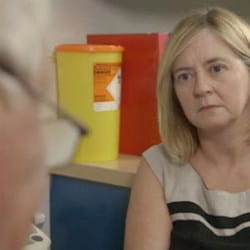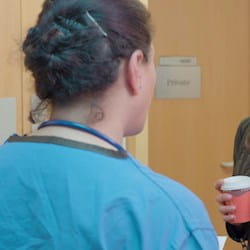The scenario below takes place over the course of a week and involves one patient and eight different members of a practice staff. There are 10 attempted and actual patient contacts. Can you see how the outcome could have been prevented?
The Previous Week
A patient who is feeling generally unwell attends her local GP practice. She consults with GP A who examines her and records 'No abnormalities detected'. He advises her to come back if not better in a couple of days.
Day one
The patient returns to the practice still feeling unwell. She has a sore throat and feels "fluey". This time the patient sees GP B who takes a blood sample and prescribes penicillin. He advises the patient to go home and take paracetamol to control her symptoms. GP B orders three blood tests: 1) FBC; 2) U&E; 3) glucose. The samples are sent off to the lab.
Day two
The results of test 1 (FBC) arrive back from the lab at 13:00 hours. Receptionist A passes the test results to GP C (duty doctor) who checks test 1 result against the consultation notes and advises "OK". There is a slightly raised WCC but nothing worrying. Medical records are updated and the patient then phones the surgery a short time later, to be told by receptionist A that her "blood test is normal".
Test 2 (U&E) returns from lab at 14:30 hours. Receptionist B passes the electronic test result to GP B; it shows a significantly raised K + level. He decides that the patient needs to be seen that afternoon and asks receptionist C to contact her.
Receptionist C attempts to call the patient twice by phone but with no success. Later that afternoon receptionist B also fails to contact the patient and informs receptionist D, who also phones the patient half an hour before closing, leaving a message asking the patient to contact the surgery, but giving no indication of any urgency. There is no subsequent contact with the patient and GP B is not reminded/informed of this before the surgery closes that evening.
Day three
Receptionist C notices that receptionists B and D had been unsuccessful in reaching the patient the previous day. She manages to contact the patient by phone and schedules an appointment with GP B that afternoon. GP B is then called away to an urgent home visit and the patient sees GP D instead. The doctor consults with the patient but only sees the results of test 1 which he does not find alarming. The results of test 3 (glucose) have now also been returned to the surgery and are viewed as normal. But the electronic result for test 2 had been temporarily saved as a blind communication between GP B and Receptionist B rather than embedded in the patient’s record. GP D does not see the test 2 result and tells the patient that nothing is seriously wrong. She leaves the surgery.
Later updating the record he discovers the test 2 result and arranges for immediate hospital admission before ringing the patient. He gets no reply and leaves an urgent message. Time passes and GP D grows increasingly worried and drives to the patient’s home only to discover the patient’s husband has already taken her to hospital. Later that day the patient dies from cardiac arrest due to complications related to her blood chemistry.
Discussion
THIS case highlights how both systems failures and human error can combine to provide the conditions for a tragic outcome. One key feature was the flawed ‘communication chain’ between the various GPs and receptionists tasked with passing on important and, in this case, life-saving information to the patient. Another failing was in the practice procedure for recording and communicating test results between staff. GP B correctly realised the significance of the U&E result and put in place a plan to contact and alert the patient. But due to the software interfaces of the results handling system, the electronic test result was temporarily saved as a ‘blind communication’ and this resulted in a potential lost opportunity on day 3 when the patient was seen by GP D.
Various other points in the chain of events offered opportunity to rescue the situation but these were missed. Chance also played a role as when GP B was called away on the urgent call at a crucial point. Some important lessons can be drawn from this study. Practices should:
- Ensure they have a written policy on results handling.
- Establish clear responsibilities and protocols for ordering, logging and marrying up test results – including multiple results.
- Implement a system for clinicians to action results where indicated and order any subsequent actions required, as well as checking up if required actions have been undertaken.
- Be aware of and act on potential electronic system defaults, which could potentially lead to a result being overlooked.
- Ensure that there is an effective mechanism in place to check and manage abnormal results, including a practice protocol for contacting patients – balancing urgency against the risk of breaching patient confidentiality.
Alan Frame is risk adviser with MDDUS Training & Consultancy Services
This page was correct at the time of publication. Any guidance is intended as general guidance for members only. If you are a member and need specific advice relating to your own circumstances, please contact one of our advisers.
Read more from this issue of Practice Manager

Save this article
Save this article to a list of favourite articles which members can access in their account.
Save to library


